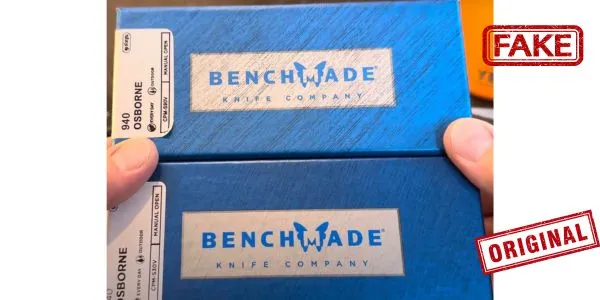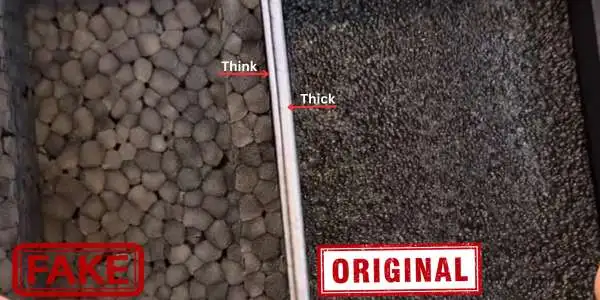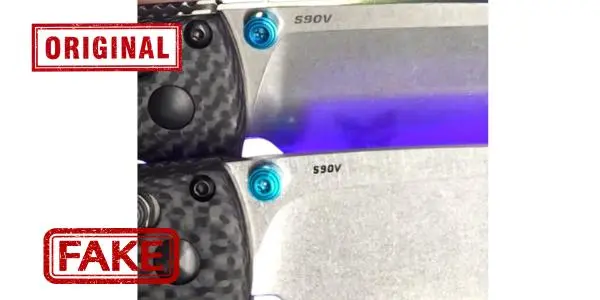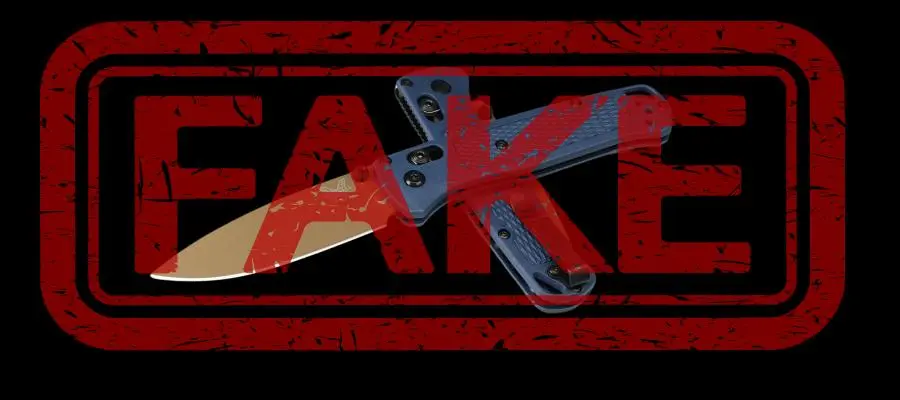In the world of knives, Benchmade stands out as a renowned brand known for its exceptional craftsmanship and quality. However, with the rise of counterfeit products flooding the market, it’s crucial for consumers to be able to distinguish between authentic Benchmade knives and fake replicas. In this article, I will walk you through how to identify signs of fake Benchmade pocket knives and equip you with the knowledge needed to make informed purchasing decisions.
1️⃣Fake Benchmade Knife Box
When you purchase a Benchmade pocket knife or intend to purchase it, a knife box is the first thing you encounter. When you take a good look at the box and what’s inside it, you can tell if you’re getting the real thing or a fake. Let’s dig into some important stuff to watch for when you’re checking out the box.

➡️Box Appearance
Firstly, pay attention to the size and color of the box. Discrepancies in box dimensions or a slight variation in color, such as a tan hue or excessive shine, may signal a counterfeit item. Take note of any irregularities in the box’s appearance.

➡️Guide Book
Inspect the paper guide inside the box. Its absence or incorrect sizing compared to authentic guides can be red flags. Genuine Benchmade knives typically include a properly sized paper guide with accurate information. As you can see in the above picture, the size of the guide book is bigger than the original.

➡️Interior Form Design
Examine the texture of the foam inside the box, and you can easily notice a big difference between the two. Authentic Benchmade packaging often features supportive foam with a molded slot to securely hold the knife. In contrast, counterfeit boxes may contain plain surface foam lacking a designated mold for the knife.

➡️Label Details
Pay attention to the details on the label, particularly the small hands logo. Genuine labels typically show a noticeable gap between the fingers of this hand logo, while fake labels may lack this gap and exhibit lower print quality. Look for signs of poor printing, indicating inferior production standards.

➡️Box Thickness
Lastly, consider the thickness of the box itself. Counterfeit boxes may be slightly thicker than genuine ones. This variation in thickness can be subtle but may indicate differences in materials or manufacturing processes.
2️⃣Check Out Benchmade Logo

A quick glance at the logo can reveal crucial differences between counterfeit and authentic Benchmade knives. Pay attention to the size and printing quality of the butterfly logo as shown in the above picture. Counterfeit versions often feature oversized logos with uneven printing. Additionally, some fake knives also missed the model number below the butterfly logo, a telltale sign of inauthenticity.
Some knives are missing the model number, but that doesn’t mean they’re fake. If you have an out-of-the-front automatic model, you may not find a model number on the blade itself. Instead, these knives typically display the Benchmade logo and the type of steel used.
Another thing to remember is that Benchmade knives made after 2000 typically don’t have a model number engraved on the blade. However, the majority of knives produced after this time do feature a model number.
3️⃣Blade Inspection

Distinguishing between fake and real knives becomes apparent when examining the blade’s quality of finishing and grinding. Authentic Benchmade blades boast a smooth and polished surface, while counterfeit blades may exhibit dullness, roughness, and unevenness.
4️⃣Handle Examination

The handle serves as another indicator of authenticity. Take note of the screw placement, as counterfeit knives often differ from the original in this aspect. Additionally, simply holding the knife can reveal differences in material quality and color finish. Authentic handles tend to exhibit a higher-quality feel and finish compared to their counterfeit counterparts.
5️⃣Thumb Studs, Lock Bars, and Pocket Clips
Even little things like thumb studs and lock bars can show differences between the fake and real versions. Variances in size, shape, and how they fit give a hint about how well the knife was made.
Looking closely at the pocket clip, you might spot small differences in how it’s designed and attached. While they might look alike at first glance, details like logo engraving and how well they fit can show if it’s the real deal or a fake.
6️⃣Attractive Pricing
Price plays a crucial role right from the start when you’re considering buying a pocket knife. It’s a key indicator that can help you spot a fake before you even spend a penny. Many sellers out there peddle counterfeit knives, and what draws customers to these scammers is often the tempting prices they offer. They may not be ridiculously low, which would immediately raise suspicions, but they’re discounted enough to make customers think they’re getting a great deal. Platforms like eBay, where you can find a lot of counterfeit pocket knives.
7️⃣Recognizing Authorized Retailers
When purchasing a Benchmade pocket knife, it’s crucial to buy from authorized retailers to guarantee authenticity. Here’s how you can identify authorized sellers:
- Official Certification: Authorized retailers often display official certifications or badges from Benchmade on their websites or storefronts.
- Verify Credentials: Before making a purchase, verify the credentials of the retailer by checking for their inclusion in Benchmade’s list of authorized dealers.
you can find the list of Benchmade authorized dealers here
Purchasing from authorized retailers not only ensures the authenticity of your Benchmade knife but also provides peace of mind, knowing that you’re investing in a genuine product.
With many sellers offering counterfeit Benchmade knives, each tries to mimic the originals, but often something’s overlooked. If the logo is spot-on, the box size might not match the original. If the box is perfect, the knife handle might have flaws. Different manufacturers make different mistakes, so it’s crucial to thoroughly inspect all aspects before making a purchase.
Conclusion
Spotting a fake Benchmade pocket knife requires keen attention to detail and thorough examination of key indicators such as craftsmanship, materials, packaging, and pricing. By utilizing official resources, purchasing from authorized retailers, inspecting product packaging, understanding price discrepancies, and exploring customer reviews, you can safeguard yourself against counterfeit replicas and ensure that your Benchmade knife is an authentic, high-quality product worthy of your investment. Remember, authenticity matters when it comes to choosing the right knife for your needs, so arm yourself with knowledge and make informed purchasing decisions.

